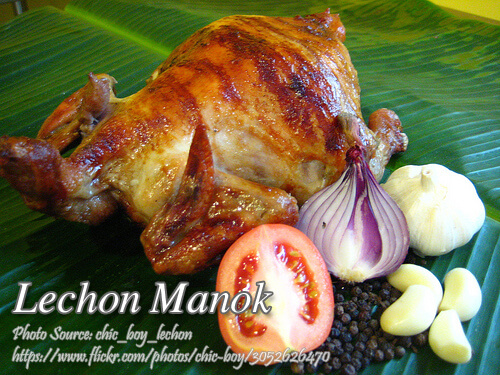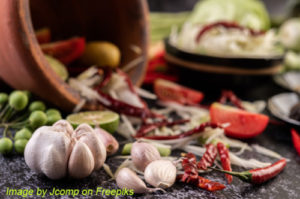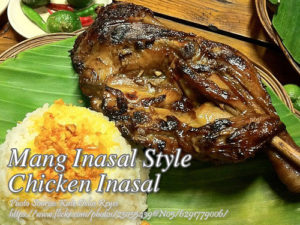Lechon manok is a roasted whole chicken over live charcoals. Compared to oven roasted chicken, charcoal roasted ones have a distinct smoked flavor and aroma. This is a popular Filipino roasted chicken and there are already many food stand selling this. But I think a home made lechon manok will taste better. The preparation of this roasted chicken is a little tedious. You have to mix all the spices and herbs in a pot and then boil it. Afterwards you will extract the juice and use a syringe to inject it in the chicken.
This will serve as the marinade. Good thing if you already have a charcoal spit rotisserie in your backyard but in case you don’t, you can improvise using a bamboo stick about an inch wide as the spit. Then a large metal basin for putting your live charcoals. Put a piece of metal rod above and center of the basin to support the other end of the bamboo stick (see photo below).

An improvised rotisserie using bamboo sticks and metal basin
Lechon Manok: Filipino Style Roasted Chicken
There’s something about the smoky, savory aroma of roasted chicken slowly roasting over live charcoal that brings me back to lazy Sunday afternoons at my Uncle Ramon’s backyard. The distinct smell of chicken, marinated with a blend of fragrant herbs and spices, filled the air as we sat around the makeshift rotisserie, sharing stories and waiting for the golden-brown perfection to be ready.
Growing up, my family always opted for homemade lechon manok rather than buying from the neighborhood stalls. Auntie Lita swore by her recipe, insisting that homemade versions taste far better because you control every bit of seasoning. She would start by preparing the marinade, a process that seemed a little tedious at first but was always worth it.
Preparing the Lechon Manok
Lechon manok isn’t just any roasted chicken. What sets it apart is the way it’s infused with flavor from the inside out. The secret, according to Uncle Ramon, is to inject the seasoned broth directly into the meat. He would make a rich, aromatic broth by simmering chicken stock with anise, lemongrass, onions, garlic, salt, and a hint of sugar. Once the mixture cooled, he would carefully strain it, reserving the herbs to stuff inside the chicken.
I remember watching in fascination as he filled a big syringe with the broth and carefully injected the chicken in multiple spots. This technique ensures that the chicken is juicy and flavorful down to the bone, rather than just seasoned on the surface. After marinating overnight, the chicken would be ready for the grill.
The Art of Charcoal Roasting
Lechon manok is traditionally roasted over live charcoal, which gives it that smoky, slightly charred flavor that’s hard to replicate with an oven. Uncle Ramon, being the resourceful cook he was, fashioned a spit using a thick bamboo stick. He’d balance it over a large metal basin filled with charcoal, slowly turning the chicken to ensure even cooking.
Grilling the chicken slowly is essential. Rushing the process can lead to burnt skin and undercooked meat. Uncle always said, “Good food takes time,” and when it came to this roasted chicken, patience really did pay off. The chicken would slowly turn golden, its skin crisping up beautifully while the meat stayed tender and moist.
Why This Technique Works
The secret to the lechon manok’s irresistible taste lies in the marinade injection and slow roasting. Injecting the broth directly into the chicken allows the flavors to permeate the meat, while slow cooking over charcoal infuses a natural, smoky essence. The gentle heat caramelizes the skin without drying out the meat, resulting in that signature juicy and flavorful bite.
A Bit of History
Lechon manok has become an iconic dish in the Philippines, a staple during celebrations and family gatherings. Its popularity grew in the late 20th century when food stalls specializing in roasted chicken started popping up in almost every town. While commercial roasted chicken is convenient, homemade versions retain a sense of tradition and craftsmanship, which is why many Filipino families still choose to make it from scratch when they can.
Serving and Enjoying
When the chicken was finally ready, Uncle would carve it right there in the backyard, revealing succulent meat wrapped in perfectly roasted skin. The aroma was mouthwatering. We’d eat it with heaps of steamed rice, dipping each piece in homemade sauce—a rich, slightly tangy blend made with liver, vinegar, and spices. Auntie Lita always said that the sauce was what tied everything together.
It’s been years since those backyard feasts, but every time I make it, I can’t help but remember Uncle Ramon’s makeshift rotisserie and Auntie Lita’s delicious sauce. It’s not just about the food; it’s about the memories wrapped around it, the stories shared over a meal, and the feeling of home.
If you’ve never tried making roasted chicken at home, give it a go. It might take a bit of effort, but the reward is a flavorful, juicy roasted chicken that’s sure to impress. Plus, you get to put your own spin on a beloved Filipino classic. Serve it with your favorite dipping sauce and plenty of rice, and enjoy the comforting taste of tradition.
How To Cook Lechon Manok (Filipino Style Roasted Chicken)
Ingredients
For the lechon manok
- 5 cloves garlic
- 1 Tbsp. anise seeds
- 4 stalks lemon grass or tanglad
- 1 pc medium size onion quartered
- 1 Tbsp. brown sugar
- Salt to taste
- 1 cup chicken soup stock or chicken bouillon cube dissolved in 1 cup hot water
- 1 whole medium size dressed chicken
For the lechon manok sauce:
- 1/2 kilo fried chicken liver
- 2 medium sized onion chopped
- 1/4 cup vinegar
- 3/4 cup brown sugar
- 2 Tbsp. bread crumbs
- 1 head garlic
- 1/2 tsp. all spice powder
- 1 Tbsp. ground black pepper
- 1 cup chicken stock
- salt to taste
Instructions
For the lechon manok:
- Put chicken stock in a saucepan and let it simmer.
- Add the ingredients anise, lemon grass, onion, salt, sugar, garlic and cover.
- After a few minutes turn off the heat and set aside.
- Strain the soup stock and reserve the spices. This will be used later to stuff the chicken.
- Get a big syringe and inject the chicken with the soup stock.
- Let the chicken marinade overnight in the fridge.
- Slowly grill the chicken over the live charcoal and baste with the oil and soup stock mixture.
- Grilling time will take about 2 to 3 hours depending on the size and weight of the chicken.
- Chicken is done when clear juice comes out of the chicken when you make a cut on the thigh part.
- Cook it until the meat is tender and the skin is brown. Serve with lechon manok sauce.
For the lechon manok sauce:
- Put all the ingredients together in a blender (except the all spice powder) until it becomes a puree .
- Pour the mixture in a saucepan and simmer for about 15 minutes or until the liver is already cooked and the sauce thickens.
- Turn off the heat then add the all spice powder. Mix well and set aside.
Notes
Cooking Tips:
Marinate Overnight for Maximum Flavor
To get that rich, savory taste, marinate your lechon manok overnight. This allows the spices and herbs to deeply penetrate the meat, making it more flavorful and juicy. The longer the marinade time, the more robust the taste.Use a Syringe for Even Seasoning
Injecting the seasoned broth directly into the chicken ensures that the flavor is evenly distributed throughout the meat. This method works better than just soaking the chicken because the liquid reaches the inner parts. It’s especially useful for larger chickens where surface marinating might not suffice.Slow Roast for Tender, Juicy Meat
Roasting the chicken slowly over low heat ensures that it cooks evenly while staying moist. Turning the spit regularly helps achieve a beautifully crispy skin without burning. Patience is key, as rushing the process can result in dry and tough meat. Let me know if you need more tips or tweaks!






Hi Jeff, thanks for the kind words!
Good Day Sir: your blog its such a great advantage & of great help for an aspiring chef like me….. pls continue sharing & more power…thank you!!!
Hi Jade, thanks for the kind words. I also appreciate it!
Thanks a lot for sharing always your tasty menu, appreciate it so much. May God bless you always for your unselfishness. Have a good day.
Kuya question lang po. How specifically are you injecting the chicken? Or just randomly inject anywhere that is meaty?
Really appreciate your website, i would still be eating ramen noodles if it werent for this website! Thanks for introducing me to cooking
Hi Vincent, you can randomly inject the chicken where there is meat of course. It doesn’t matter what part but I would suggest the breast part is the best because it is dry.
Yes Mirasol, you can baste it while roasting your chicken.
Hi, can I use anatto oil to make the chicken look more appetizing?
Kuya Asan na Po yung old recipe mo sa litson manok? Na may lemon grass, ginger vinegar at sugar lang ata yun diba. Na miss ko na Po iyon. Gusto ko I try ulit. Sa pagka alala ko sa basting mo is gumamit ka ng asuete oil at iba pa.
@Meldrid Jones
Sorry po wala pong ganung recipe dito.
nice blog 🙂 lechon will be a star this Christmas 🙂
We have a delicious lechon in Caloocan City
maraming salamat po….
sorry po,pero confused,lang ako regarding sa(1 cup chicken stock)saan tayo pwd makakuha non.
@GERUM
Ang chicken stock po ay sabaw ng nilagang manok. Pwede ring chicken bouillon cubes dissolve in 1 cup of hot water.
ang sasarap naman ang mag pagkaing niluluto mo kuya . more pwer and GOD BLESS U PO TOGETHER WITH UR LOVING FAMILIES.
@Carmela
Thanks and hoping you will visit often and share this site to your friends and families.